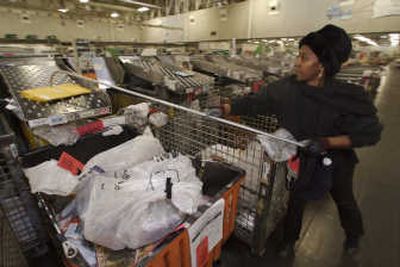Post office seeks tech edge, looking for revenue

NEW YORK – Marty Sellers used to need about a hundred postage stamps every three months. These days, he can stretch that supply to last a year.
Sellers, 40, now pays most bills online and receives financial statements electronically. The owner of Sellers Photo in Huntsville, Ala., also has cut down on mailing clients CDs, transferring images over the Internet instead.
“Even things like a birthday card, I will just send a happy birthday e-mail,” he said.
Because many people around the world are like Sellers, the U.S. Postal Service and its counterparts in other countries are tapping technology to cut costs and expand into electronic services – including services designed to attract more “junk” mail.
In the United States, first-class mail volume has dropped 7 percent since 2001 – an average of 1.3 billion fewer letters, postcards and bills each year. A 15 percent boost in bulk advertising and other discounted mailings has so far offset only some of the loss in revenue.
While postal agencies worldwide have tried to find new revenue opportunities, not all efforts have been successful.
For lack of demand, the U.S. Postal Service canceled a few programs it started in 1999 and 2000, including electronic bill payments – which the private sector now offers with greater success.
“If we look back to the boom days of the Internet … there was a surge of e-commerce-related activities in a lot of posts,” said Luis Jimenez, chief industry policy officer for Pitney Bowes Inc., a mail and document-management company. “That was primarily motivated by a fear that mail would decline precipitously and they needed a new source of income.
“The realization came just a few short years after that it’s very difficult to make money from e-commerce.”
Now, most electronic efforts supplement traditional, physical mail. In the United States, that includes ordering stamps and packing supplies online and providing delivery confirmation electronically without mailing back a receipt.
The USPS also helps retailers like L.L. Bean Inc. generate preprinted labels to include with shipments for merchandise returns. Merchants, including eBay Inc. auction participants, also can create shipping labels and buy postage online.
Jimenez said the refocus comes as postal agencies find that mail volume isn’t dropping as quickly as once feared. E-mail isn’t replacing all letters and cards; partly, it’s creating communication that might not have occurred otherwise. The Internet also has created new mailing opportunities from e-commerce sales, digital photo printing and DVD rentals.
And many people remain more comfortable with paper.
“I just find paper records more reliable and trustworthy,” said David Hildebrand, 72. “They all push me to get electronic statements, but I can’t put them in a drawer and I can’t look at them when the computer doesn’t work.”
Hildebrand is no technophobe. The retired IBM Corp. computer programmer from San Jose, Calif., started visiting online bulletin boards and sending e-mail in the mid-1980s – back when few friends even had computers.
“We’re going to use more paper, not less, for the short and medium term,” said Paul Saffo, a technology forecaster in San Mateo, Calif.
That means postal agencies can benefit for several more years by cutting costs through automation and measures like installing kiosks to reduce labor-intensive window transactions. A new change-of-address system in the United States reduces costs by redirecting mail earlier in the process.
By next year, U.S. bulk mailers also will have to start using intelligent bar codes – with 31 instead of 11 digits of data, allowing for refined tracking and earlier identification of undeliverable addresses.
But ultimately, the challenge will be creating new revenue streams.
Hybrid services represent one tactic. France, Italy and the United States let people send documents electronically for printing and delivery by the post. Italy also has a reverse service, scanning physical mail into digital form – which can be great for government agencies needing to distribute items to scores of branch offices.
Other strategies could involve increasing the value of snail mail with, for example, the intelligent bar codes, which can tell U.S. mailers which mailings arrive when and help them remove bad information from their mailing lists.